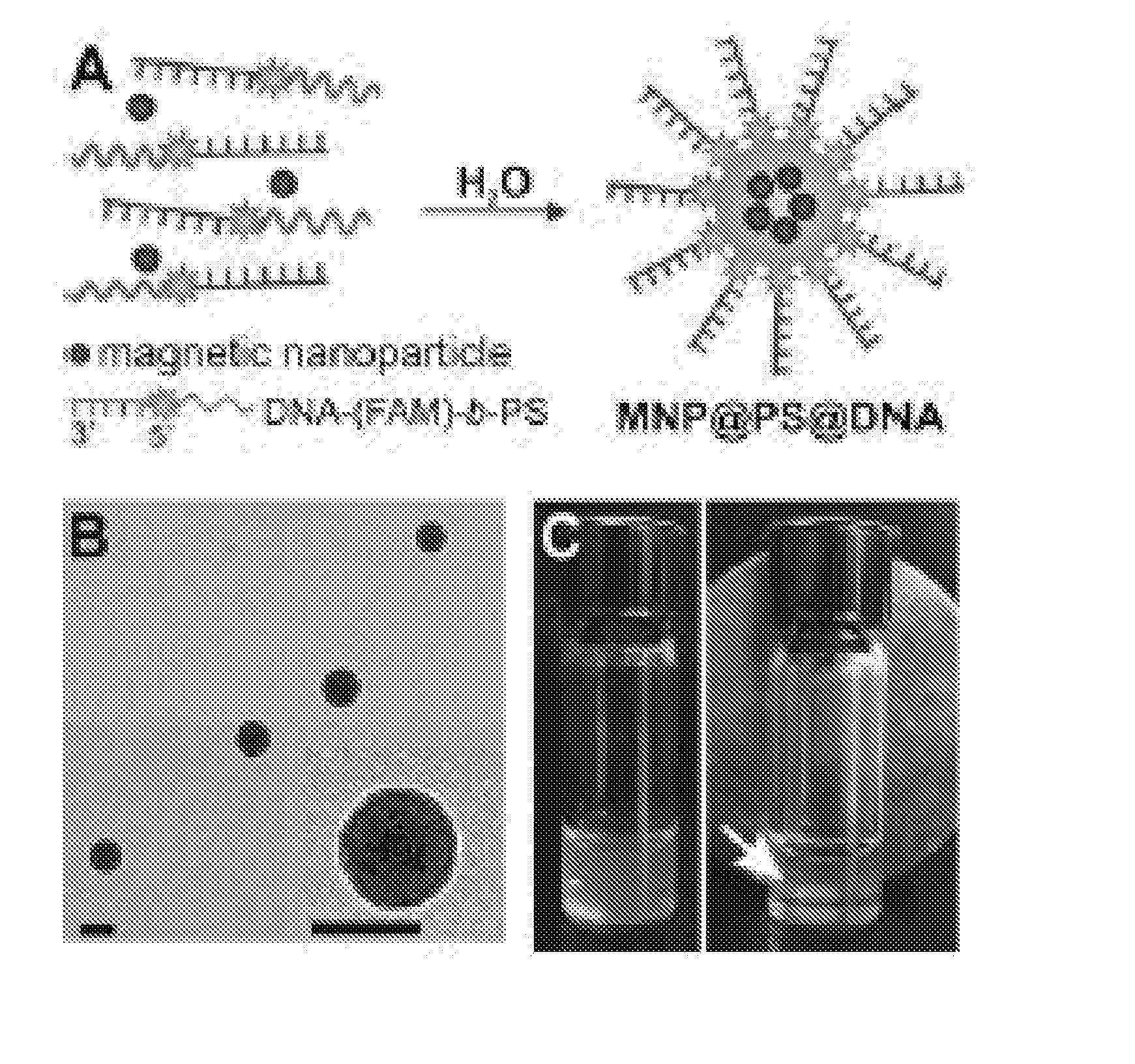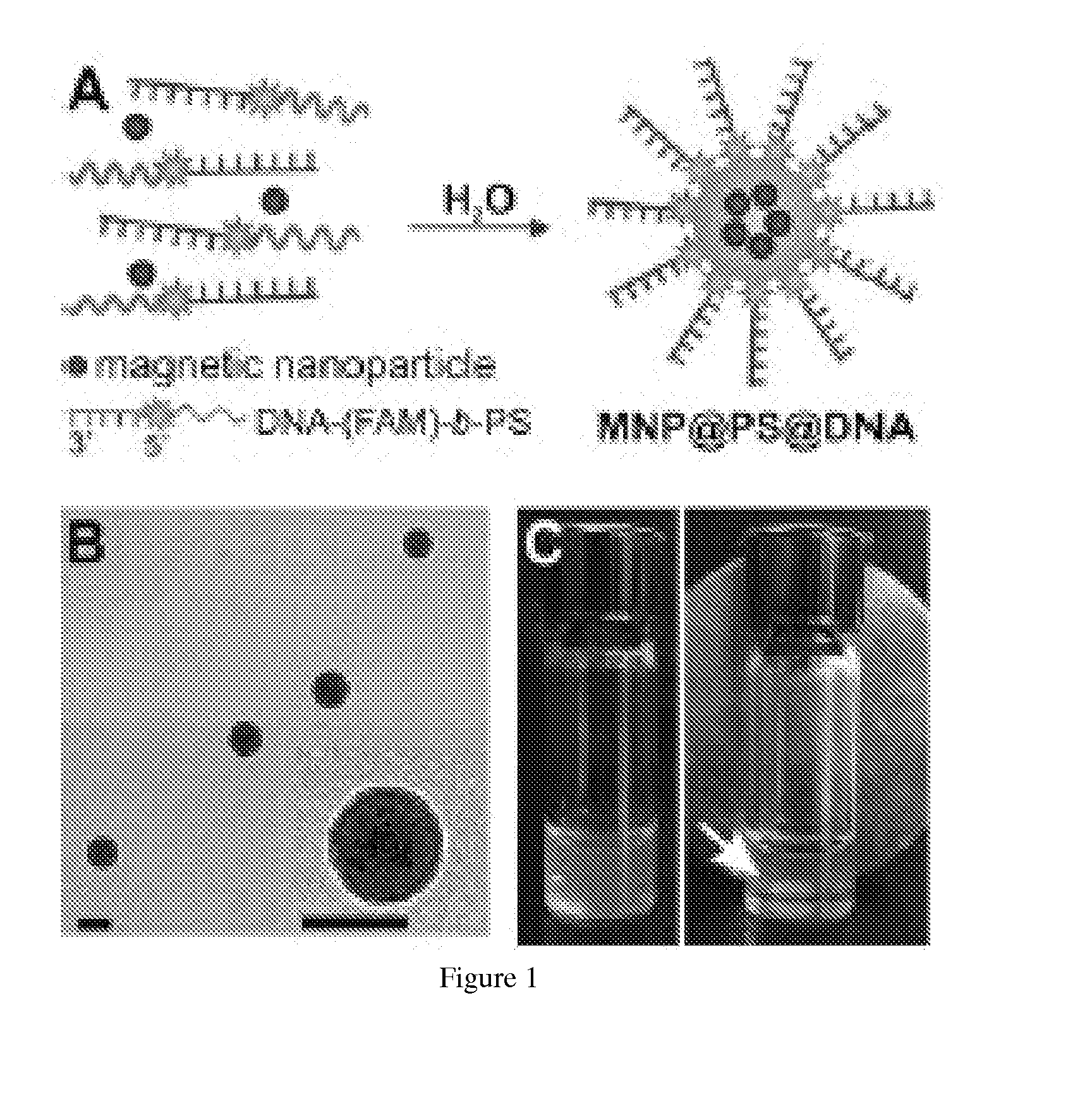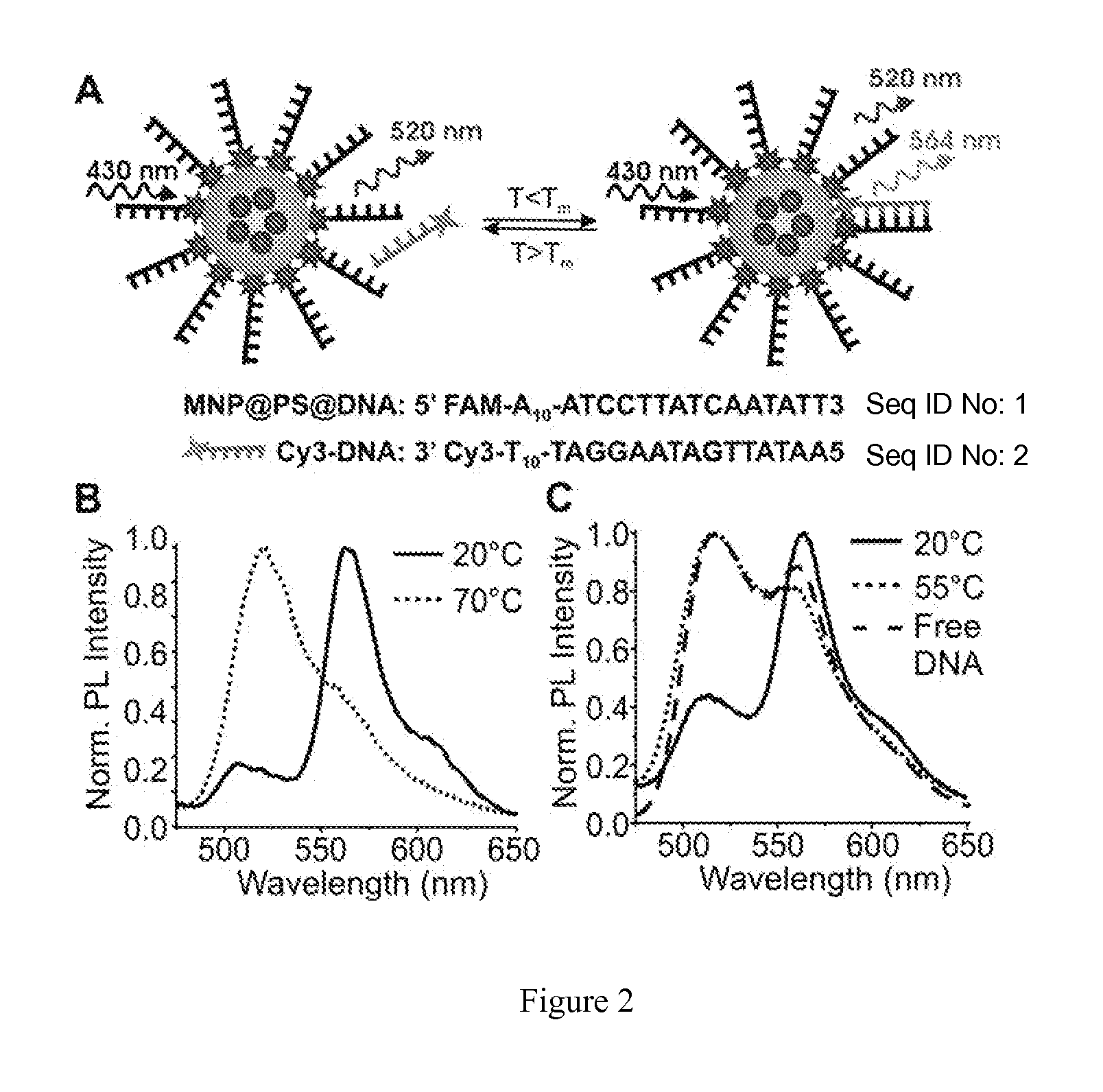Nanop article-oligonucleotide hybrid structures and methods of use thereof
a technology of article and oligonucleotide, which is applied in the field of nanoparticle-oligonucleotide hybrid structures, can solve the problems of the inability to obtain high density dna on the surface of those nanoparticles, and achieve the effect of high selectivity
- Summary
- Abstract
- Description
- Claims
- Application Information
AI Technical Summary
Benefits of technology
Problems solved by technology
Method used
Image
Examples
example 1
Synthesis of Amphiphilic Block-Copolymers
[0071]In typical experiments, amphiphilic block-copolymers composed of an oligonucleotide block and a polystyrene block (DNA-b-PS) were synthesized by coupling phosphoramidite-modified PS (Mn=10.4 Kg / mol) to oligonucleotides grown on controlled pore glass (CPG) beads. To monitor DNA hybridization properties (vide infra), fluorescein (FAM) was inserted in-between DNA and PS by attaching FAM at the 5′ end of DNA. PS-modified iron oxide magnetic nanoparticles (MNP) were prepared from oleic-acid stabilized MNPs (diameter: 5.0±0.3 nm) via ligand exchange with α-carboxyl PS. DNA block-copolymers and nanoparticles were self-assembled by first mixing them in a relatively good solvent (i.e. DMF), followed by the slow addition of water to the mixture and overnight dialysis in water (FIG. 1). The prepared hybrid particles of block-copolymers and magnetic nanoparticles (MNP@PS@DNA) were collected by centrifugation or by using a magnet (FIG. 1C), and tran...
example 2
DNA Hybridization Properties of Hybrid Particles of Block-Copolymers and Magnetic Nano Particles (MNP@PS@DNA)
[0072]Properties of MNP@PS@DNA were evaluated by hybridizing Cy3-modified complementary target DNA (Cy3-DNA: 3′ Cy3-T10-TAGGAATAGTTATAA5′) (SEQ ID NO: 2) to the FAM-modified DNA (5′FAM-A10-ATCCTTATCAATATT3′) (SEQ ID NO: 1) on MNP@PS@DNA (FIG. 2). DNA hybridization events were monitored by measuring the Forster resonance energy transfer (FRET) between FAM on MNP@PS@DNA and Cy3 on Cy3-DNA (FIG. 2A). FIG. 2B presents fluorescence spectra of 0.3 M phosphate buffered saline solution (PBS, pH 7, 10 mM phosphate buffer, 0.3 M NaCl, 800 μL) containing MNP@PS@DNA ([DNA-b-PS]: 200 pmol) and Cy3-DNA (800 pmol), taken with 430 nm excitation where Cy3 does not absorb strongly. As Cy3-DNA binds to MNP@PS@DNA, Cy3 fluorescence intensity (564 nm) increases relative to that of FAM (520 nm) due to energy transfer from FAM to Cy3 (FIG. 2B, solid). The FRET efficiency (EFRET) of the sample was d...
example 3
Binding Capability and Selectivity of MNP@PS@DNA
[0074]The high binding capability of MNP@PS@DNA compared to isolated DNA strands was unambiguously demonstrated by a “competition experiment” (FIG. 3) where Cy5-modified DNA strands (Cy5-DNA: 5′Cy5-A10-ATCCTTATCAATATT3′) (SEQ ID NO: 3) with the same sequence as the DNA in MNP@PS@DNA were mixed with Cy3-DNA and MNP@PS@DNA in water (FIG. 3A). In this scheme, the increase in Cy5 signal (668 nm) with 525 nm excitation indicates duplex formation between Cy3-DNA and Cy5-DNA, and the increase in Cy3 signal (564 nm) with 430 nm excitation indicates binding of Cy3-DNA to MNP@PS@DNA nanoparticles. FIG. 3B presents emission spectra collected at 430 nm excitation, which clearly showed hybridization between Cy3-DNA and MNP@PS@DNA. When excited at 525 nm, Cy3 emission was again dominant in the emission spectrum (FIG. 3C, solid), which indicated that Cy5-modified competition DNA (Cy5-DNA) did not bind to Cy3-modified target DNA (Cy3-DNA) at the condi...
PUM
| Property | Measurement | Unit |
|---|---|---|
| size | aaaaa | aaaaa |
| diameter | aaaaa | aaaaa |
| diameter | aaaaa | aaaaa |
Abstract
Description
Claims
Application Information
 Login to View More
Login to View More - R&D
- Intellectual Property
- Life Sciences
- Materials
- Tech Scout
- Unparalleled Data Quality
- Higher Quality Content
- 60% Fewer Hallucinations
Browse by: Latest US Patents, China's latest patents, Technical Efficacy Thesaurus, Application Domain, Technology Topic, Popular Technical Reports.
© 2025 PatSnap. All rights reserved.Legal|Privacy policy|Modern Slavery Act Transparency Statement|Sitemap|About US| Contact US: help@patsnap.com



